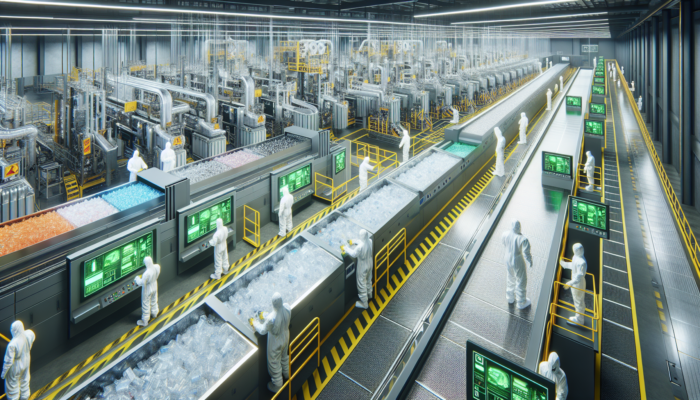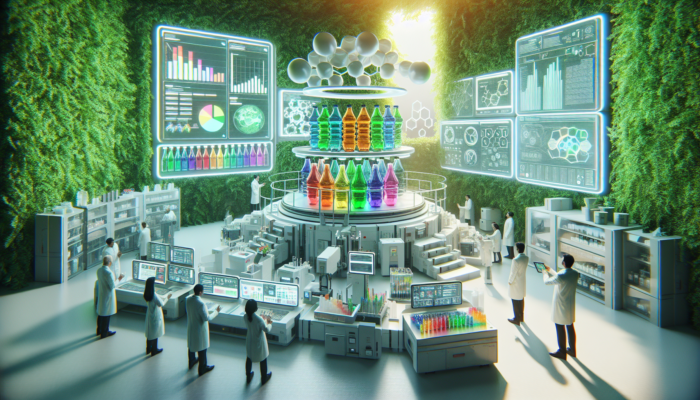Transform Waste Management with Cutting-Edge Recycling Techniques for a Sustainable Future
Discover Innovative Recycling Techniques to Maximize Resource Recovery
Advanced recycling methods for clearance signify a groundbreaking advancement in waste management practices. These innovative techniques leverage state-of-the-art technology to convert discarded materials into valuable resources, a significant upgrade from traditional recycling methods that often face challenges with sorting and processing inefficiencies. The advanced techniques incorporate sophisticated processes that effectively decompose complex materials, thereby enhancing recovery efficiency. This revolutionary strategy not only improves the quality of raw materials extracted from waste but also diminishes the dependence on virgin resources, promoting a sustainable approach to resource utilization.
Central to these methodologies is the idea of a circular economy, which fundamentally changes the perception of waste from a burden to a resource. This essential shift is crucial for businesses and communities striving to enhance their sustainability practices and environmental responsibility. Cutting-edge technologies, including chemical recycling, pyrolysis, and enzymatic recycling, are leading this transformative movement, each providing distinct benefits in terms of material recovery and quality. By embracing these advanced methods, organizations can substantially lower their environmental impact and actively contribute to a sustainable future.
The Critical Importance of Waste Clearance for Enhanced Recycling Efficiency
Clearance is a vital component of effective waste management, particularly in the context of advanced recycling methods for clearance. This process involves the strategic removal of waste from various sources, ensuring careful sorting and processing of materials. Such a meticulous approach is essential for maximizing recycling operations' efficiency, as it significantly reduces contamination that could compromise the quality of recycled materials.
Implementing effective clearance strategies is essential for businesses, municipalities, and diverse industries, as they encourage proper waste segregation and responsible disposal practices. By developing robust clearance protocols, organizations can guarantee that recyclable materials are diverted from landfills, thereby boosting recovery rates and supporting the circular economy. Furthermore, efficient clearance can improve compliance with environmental regulations and positively influence public perceptions of waste management, fostering a culture of sustainability within communities.
Environmental Benefits of Cutting-Edge Recycling Techniques
The environmental advantages of advanced recycling methods for clearance are considerable, especially in relation to reducing landfill waste and lowering greenhouse gas emissions. Traditional waste management methods often lead to significant ecological damage, with large quantities of waste accumulating in landfills, causing soil contamination and water pollution. In contrast, advanced recycling technologies present a viable alternative by redirecting waste away from landfills and transforming it into valuable materials that can be reintegrated into manufacturing processes.
Moreover, advanced recycling plays a crucial role in reducing the carbon footprint associated with material production by decreasing the need for virgin resources. This aspect is especially relevant in the ongoing battle against climate change, where raw material extraction and processing are typically energy-intensive and harmful to the environment. By adopting advanced recycling methods, organizations contribute to a healthier planet while aligning with global sustainability objectives, thereby enhancing their corporate social responsibility initiatives.
Innovative Technologies Transforming Advanced Recycling Methods for Waste Clearance

Revolutionizing Plastic Waste Management with Chemical Recycling
chemical recycling is a pivotal component of advanced recycling methods for clearance, providing a transformative answer to plastic waste management challenges. This process involves breaking down plastics into their basic monomers, which can then be repurposed to manufacture new, high-quality materials. Unlike traditional recycling methods that may degrade the quality of plastics over time, chemical recycling guarantees the creation of new products that retain the original material characteristics.
The adaptability of chemical recycling is particularly remarkable, as it can be applied to a range of plastic types, including those that are typically challenging to recycle, such as mixed plastics and contaminated items. By adopting this innovative technology, organizations can significantly improve their recycling rates and divert substantial amounts of waste from landfills. Moreover, producing high-quality recycled materials through chemical processes can greatly reduce the demand for virgin plastics, thereby fostering sustainable manufacturing practices.
Harnessing Energy from Waste: The Impact of Pyrolysis and Gasification
Pyrolysis and gasification are two highly efficient thermal processes utilized in advanced recycling methods for clearance. These innovative techniques involve the thermal degradation of organic materials in an oxygen-free environment, converting waste into energy and essential raw materials. Pyrolysis specifically focuses on transforming plastics into oils, gases, and char, which can be further refined or used as fuel.
Conversely, gasification converts carbon-rich materials into syngas, a blend of hydrogen and carbon monoxide that can be harnessed to generate electricity or produce synthetic fuels. Both processes significantly enhance recycling efficiency by minimizing waste volumes and generating energy that can be utilized across various applications. By incorporating pyrolysis and gasification into waste management strategies, organizations can realize considerable cost savings while mitigating environmental impacts, making these methods invaluable in the pursuit of sustainability.
Innovative Breakthroughs in Enzymatic Recycling Techniques

Enzymatic recycling represents an innovative and promising technique that employs biological agents to decompose plastics, offering a unique and environmentally friendly solution within advanced recycling methods for clearance. This approach utilizes specific enzymes that can break down complex polymer structures into their monomers, which can then be reused to manufacture new plastic products. By leveraging natural biological processes for recycling, this method enhances waste management efficiency while aligning with broader sustainability goals.
A notable benefit of enzymatic recycling is its ability to target specific types of plastics, making it particularly effective for materials that pose challenges for conventional recycling methods. Additionally, this process operates at relatively low temperatures and does not require harmful solvents, significantly reducing its ecological footprint. As research and development in this area continue to progress, enzymatic recycling has the potential to redefine our approach to plastic waste management, paving the way for a more circular economy.
A Thorough Guide to Implementing Advanced Recycling Techniques for Waste Clearance
Evaluating Your Organization’s Unique Recycling Needs
Before implementing advanced recycling methods for clearance, organizations must perform a comprehensive assessment of their specific recycling requirements. This evaluation includes a detailed audit of the types and volumes of waste generated within the organization. Gaining a clear understanding of waste stream composition allows businesses to tailor their recycling strategies to effectively address their unique challenges.
The first step is to identify the primary materials present within the waste stream. For example, an organization generating a significant amount of plastic waste may find substantial benefits in adopting chemical recycling technologies, while a facility focused on organic waste could explore enzymatic solutions. Furthermore, understanding waste volumes helps determine the scale of recycling operations needed, ensuring that selected methods are both efficient and cost-effective. This thorough evaluation lays the groundwork for successful implementation while maximizing resource recovery potential.
Selecting the Most Appropriate Technology for Effective Recycling
Choosing the right technology for advanced recycling methods for clearance is a critical decision that can significantly affect the success of waste management initiatives. Factors such as cost, environmental impact, and the specific materials requiring recycling should guide this selection process. Each technology—be it chemical recycling, pyrolysis, or enzymatic methods—offers its unique advantages and considerations.
Conducting a cost analysis is essential; organizations must balance the initial investment for technology installation against the long-term savings associated with resource recovery and reduced disposal expenses. Additionally, environmental impact should be a primary concern as organizations strive to lower their carbon footprints and align with sustainability goals. Ultimately, the specific materials produced by an organization will dictate the most suitable technologies, ensuring that selected methods effectively tackle waste challenges while maximizing recovery rates.
Focusing on Staff Training and Education for Successful Implementation
To optimize the efficiency and safety of advanced recycling methods for clearance, comprehensive training and education for staff are vital. Employees play a crucial role in the success of recycling initiatives, and equipping them with the necessary skills and knowledge can significantly enhance the effectiveness of waste management strategies.
Training programs should encompass a variety of topics, including the operation of advanced recycling technologies, effective waste segregation techniques, and the importance of adhering to environmental regulations. Moreover, fostering a culture of sustainability in the workplace can motivate employees to actively participate in recycling efforts and advocate for responsible waste management practices. By investing in staff education, organizations can ensure they are well-prepared to implement advanced recycling methods successfully, ultimately leading to improved resource recovery and a reduced environmental footprint.
Real-World Success Stories: Advanced Recycling Methods for Clearance in Action
Innovative Approaches in Industrial Waste Management
A prime example of advanced recycling methods for clearance is seen in the industrial sector, where a manufacturing facility effectively adopted chemical recycling processes to manage its plastic waste. Faced with rising disposal costs and stringent environmental regulations, the facility recognized the necessity for a more sustainable waste management approach.
By implementing a chemical recycling system, the plant successfully converted its plastic waste into high-quality raw materials suitable for reuse in production. This strategy not only reduced the amount of waste sent to landfills but also significantly lowered material costs, as the plant could procure recycled materials at a fraction of the cost of virgin plastics. The success of this initiative not only improved the plant’s financial performance but also established its reputation as a pioneer in sustainability within the industry.
Engaging Community Recycling Initiatives
In the realm of municipal recycling, cities around the globe have begun to adopt advanced recycling methods for clearance to enhance waste management and effectively engage the public. A notable example is a city that launched a comprehensive recycling program incorporating both chemical recycling and enzymatic solutions.
The city implemented extensive public awareness campaigns to educate residents about the significance of recycling and the advantages of advanced methods. Consequently, participation rates in the recycling program soared, resulting in a considerable increase in the volume of materials collected. By integrating advanced technologies, the city successfully processed previously unrecyclable plastics, diverting them from landfills and reducing overall waste generation. This initiative not only bolstered the municipality’s sustainability efforts but also cultivated a sense of community responsibility towards waste management.
Innovative Recycling Advancements in the Commercial Sector
The commercial sector has also experienced remarkable innovations through the adoption of advanced recycling methods for clearance. Many businesses are now utilizing advanced recycling technologies to fulfill sustainability objectives while simultaneously reducing operational costs. For instance, a leading retailer collaborated with a technology provider to establish a closed-loop recycling system for its packaging materials.
By employing pyrolysis technology, the retailer converted its plastic packaging waste into reusable raw materials, significantly minimizing its reliance on new plastic production. This initiative not only advanced the retailer's sustainability goals but also strengthened its market position as an environmentally responsible brand. The success of such commercial innovations highlights the potential for advanced recycling to yield both economic and ecological benefits.
Economic Advantages of Advanced Recycling Methods for Clearance
Realizing Cost Savings Through Effective Resource Recovery
One of the most compelling benefits of advanced recycling methods for clearance is the substantial cost savings achievable through efficient resource recovery. By converting waste into valuable materials, organizations can dramatically reduce their disposal costs while simultaneously offsetting expenses related to procuring virgin materials. This dual advantage creates a robust financial incentive for businesses to invest in advanced recycling technologies.
Furthermore, as waste management regulations become increasingly stringent, the financial risks associated with non-compliance can be significant. By implementing advanced recycling methods, organizations can mitigate the chances of incurring fines and penalties linked to improper waste disposal. The long-term savings gained from improved resource recovery and diminished compliance costs create a compelling business case for adopting advanced recycling strategies.
Encouraging Job Creation and Economic Development
The expansion of the recycling industry through advanced recycling methods for clearance plays a crucial role in job creation and economic advancement. As organizations invest in advanced technologies, there arises a corresponding demand for skilled professionals to operate and maintain these systems. This trend fosters new job opportunities across various sectors, including engineering, operations, and environmental management.
Moreover, the growth of the recycling industry stimulates local economies by promoting investment in innovative technologies and infrastructure. Communities prioritizing sustainability and advanced recycling often experience enhanced economic resilience, positioning themselves as hubs for innovation and resource recovery. The positive impacts of job creation and economic growth linked to advanced recycling methods underscore the importance of embracing sustainability as a catalyst for economic development.
Investment Opportunities in Advanced Recycling Technologies
As the demand for sustainable solutions continues to rise, investment opportunities in advanced recycling methods for clearance are becoming increasingly appealing. Investors are recognizing the potential for significant returns in the recycling sector, especially as new technologies are developed and existing processes are optimized.
Companies focusing on advanced recycling technologies are attracting venture capital and private equity investments, driven by the growing acknowledgment of effective waste management's role in addressing environmental issues. Furthermore, public-private partnerships within the recycling sector can facilitate the development of innovative solutions, paving the way for further advancements in recycling technologies. As the market for recycled materials expands, the potential for lucrative investments in advanced recycling presents an enticing opportunity for forward-thinking investors.
Addressing Challenges in Implementing Advanced Recycling Methods for Clearance
Overcoming Technological Barriers
Implementing advanced recycling methods for clearance involves navigating various challenges, particularly in overcoming technological obstacles. Many organizations may find it difficult to integrate new technologies into their existing waste management systems, raising concerns regarding cost, efficiency, and compatibility.
To address these challenges, organizations should undertake thorough evaluations of potential technologies, considering scalability, ease of integration, and operational requirements. Collaborating with technology providers and industry experts can facilitate smoother transitions and offer valuable insights into best practices. By proactively tackling technological challenges, organizations can enhance their recycling capabilities and maximize the advantages of advanced methods.
Navigating Regulatory and Policy Frameworks
The regulatory landscape surrounding advanced recycling methods for clearance is continuously evolving, presenting organizations with both challenges and opportunities. Understanding the implications of local, national, and international regulations is essential for ensuring compliance and successfully implementing advanced recycling initiatives.
Organizations should actively engage with policymakers to advocate for regulations that promote the adoption of advanced recycling technologies. This includes supporting policies that incentivize investment in recycling infrastructure and streamline permitting processes. By fostering collaborative dialogues between industry stakeholders and regulators, organizations can help cultivate a supportive policy environment that encourages the growth of advanced recycling methods.
Enhancing Public Perception and Engagement
Public perception significantly influences the success of advanced recycling methods for clearance, as community engagement and support are crucial for effective implementation. Many individuals may hold misconceptions about recycling technologies, leading to resistance or indifference towards new initiatives.
Organizations must prioritize education and outreach to overcome these challenges and enlighten the public about the advantages of advanced recycling methods. This can involve hosting workshops, community events, and educational campaigns that emphasize the significance of recycling and the positive outcomes of advanced technologies. By fostering a better understanding of recycling processes and their benefits, organizations can enhance public support and participation in sustainability initiatives.
Forecasting Future Innovations in Advanced Recycling Techniques for Clearance
Emerging Technologies to Monitor
The realm of advanced recycling methods for clearance is rapidly evolving, with several emerging technologies set to transform waste management practices. Innovations in artificial intelligence, machine learning, and biotechnology are paving the way for more efficient and effective recycling processes.
For instance, AI-driven sorting systems can significantly enhance material recovery rates by accurately identifying and separating various types of waste. Furthermore, advancements in biotechnology, such as enzyme engineering, are leading to more effective methods for deconstructing complex materials. As these technologies continue to develop, they hold the potential to revolutionize the recycling industry and promote the broader adoption of advanced recycling methods.
Integrating AI and Automation into Recycling Processes
Artificial intelligence (AI) and automation are increasingly vital in improving the efficiency of advanced recycling methods for clearance. By incorporating AI into recycling operations, organizations can optimize sorting processes, monitor equipment performance, and streamline logistics.
Automated sorting systems equipped with AI algorithms can substantially improve the accuracy of material separation, reducing contamination and maximizing recovery rates. In addition, AI-driven predictive maintenance can help minimize equipment downtime and extend the lifespan of recycling machinery. As AI and automation advance, integrating them into recycling practices will be essential for organizations seeking to maintain competitiveness in the ever-evolving waste management landscape.
Fostering Global Collaboration and Knowledge Sharing
As the world confronts escalating environmental challenges, global collaboration and knowledge exchange are becoming increasingly crucial in advancing recycling methods for clearance. International partnerships among governments, businesses, and research institutions can facilitate the sharing of best practices and spur innovation in recycling technologies.
Collaborative initiatives can lead to the establishment of comprehensive recycling frameworks addressing regional waste management challenges while promoting global sustainability. By exchanging knowledge and expertise, stakeholders can accelerate the adoption of advanced recycling methods, working together towards a more sustainable future.
Frequently Asked Questions About Advanced Recycling Methods for Clearance
What are advanced recycling methods?
Advanced recycling methods refer to innovative technologies that convert waste materials into valuable resources, surpassing the capabilities of traditional recycling techniques.
How do advanced recycling methods minimize environmental impact?
These methods reduce landfill dependency and greenhouse gas emissions by transforming waste into reusable materials, supporting sustainability objectives.
What technologies are utilized in advanced recycling?
Key technologies include chemical recycling, pyrolysis, gasification, and enzymatic recycling, each offering unique advantages for material recovery.
How can businesses successfully implement advanced recycling methods?
Organizations should assess their waste streams, select suitable technologies, and invest in staff training to effectively implement advanced recycling strategies.
What economic advantages do advanced recycling methods offer?
Advanced recycling can lead to cost savings through effective resource recovery, job creation, and appealing investment opportunities in recycling technologies.
What challenges do organizations face when implementing advanced recycling?
Common obstacles include technological barriers, regulatory considerations, and public perceptions regarding new recycling methods.
How can public perception of advanced recycling be improved?
Organizations can enhance public understanding of the benefits of recycling through educational outreach, community events, and transparent communication.
What future trends can we expect in advanced recycling?
Emerging technologies, AI integration, and global collaboration are key trends anticipated to shape the future of advanced recycling methods.
What role does AI play in recycling processes?
AI enhances recycling efficiency by improving sorting accuracy, monitoring equipment performance, and optimizing logistics within recycling operations.
How can cities benefit from advanced recycling methods?
By implementing advanced recycling technologies, cities can enhance waste management, increase recycling rates, and foster public engagement.
Connect with us on Facebook!
The Article: Advanced Recycling Methods: Transforming Waste Management Was First Found At https://birminghamhouseclearance.com
The Article Advanced Recycling Methods for Effective Waste Management Was Found On https://limitsofstrategy.com


What a fascinating dive into the world of advanced recycling methods – it’s like the superhero reboot we’ve all been waiting for in waste management! I must admit, I’ve often found myself in a philosophical jam while staring longingly at my recycling bin, wondering how many times I’ve unknowingly played “Guess that Plastic Number.” Seriously, the struggle is real! But your discussion of cutting-edge techniques really sparks some hope.
It’s great to hear that you found the article resonates with your recycling adventures—let’s be honest, staring down at that recycling bin can feel like some kind of cruel game show where the prize is a cleaner planet but the host keeps changing the rules. “Guess that Plastic Number” can be more stressful than a high-stakes poker game, especially when you find yourself Googling “What do I do with this oddly shaped container that claims to be made from recyclable material but has seven different symbols on it?”
I’m so glad you enjoyed the article! If you’re curious to explore more about these game-changing recycling innovations, check out this insightful resource that dives even deeper into the future of waste management.
https://firstlightcycle.co.uk/eComToolkit
It’s interesting how something as routine as looking into our recycling bins can stir up such deep reflections, isn’t it? The whole “Guess that Plastic Number” game can feel like wandering through a maze with no clear exit sometimes. I get it—I’ve found myself deliberating over which plastics are truly recyclable and which ones just end up as more waste.